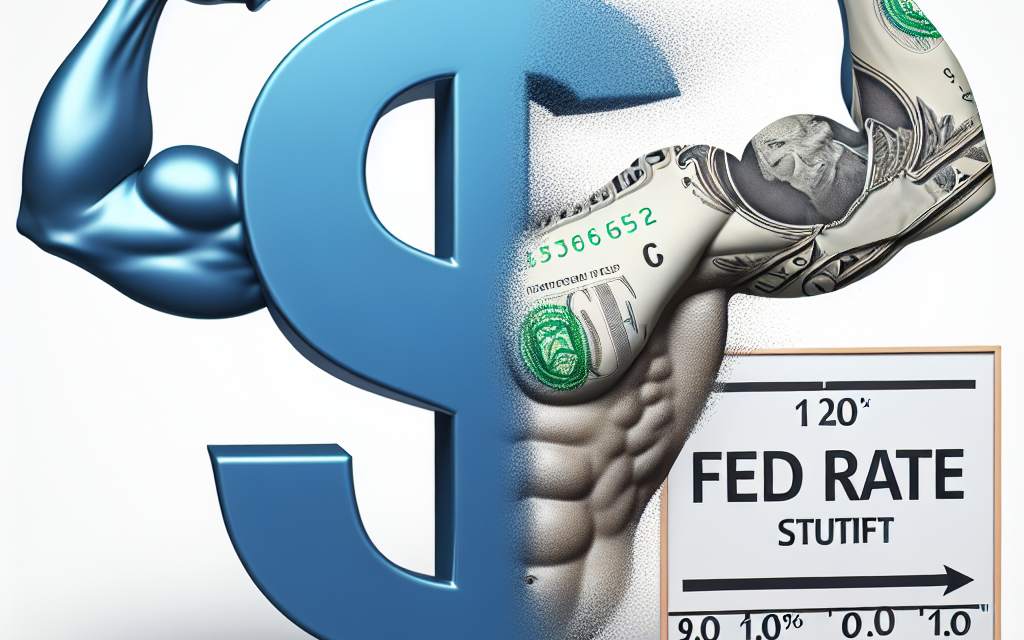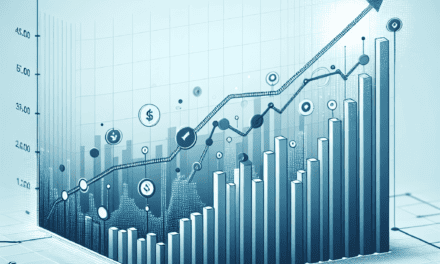“Dollar Gains Ground as Fed Rate Cut Hopes Fade.”
Introduction
The recent strengthening of the U.S. dollar can be attributed to diminishing speculations surrounding potential interest rate cuts by the Federal Reserve. As economic indicators suggest resilience in the U.S. economy, market participants are reassessing their expectations for monetary policy. The Fed’s commitment to maintaining a stable inflation rate and supporting economic growth has led to a more hawkish outlook, bolstering confidence in the dollar. This shift in sentiment has resulted in increased demand for the currency, impacting global markets and trade dynamics. As investors recalibrate their strategies in response to these developments, the dollar’s strength reflects broader economic trends and the Fed’s evolving stance on interest rates.
Dollar Strength and Economic Indicators
In recent weeks, the U.S. dollar has demonstrated notable strength against a basket of major currencies, a trend that can be attributed to a variety of economic indicators and shifting market sentiments. As speculations surrounding potential rate cuts by the Federal Reserve begin to wane, the dollar’s resilience has become increasingly evident. This shift in perception is largely influenced by a series of economic data releases that suggest a more robust economic landscape than previously anticipated.
To begin with, the labor market has shown signs of resilience, with unemployment rates remaining at historically low levels. This stability in employment not only bolsters consumer confidence but also supports spending, which is a critical driver of economic growth. As consumers continue to engage in spending activities, the overall economic outlook appears more favorable, leading to increased demand for the dollar. Furthermore, wage growth has also been a contributing factor, as rising incomes enhance purchasing power and stimulate economic activity.
In addition to labor market indicators, inflation data has played a significant role in shaping the dollar’s trajectory. Recent reports indicate that inflation, while still a concern, has shown signs of moderation. This moderation alleviates some pressure on the Federal Reserve to implement aggressive rate cuts, which had been a topic of speculation in earlier months. As inflation expectations stabilize, investors are reassessing their positions, leading to a stronger dollar as confidence in the U.S. economy grows.
Moreover, the Federal Reserve’s recent communications have also influenced market perceptions. Fed officials have signaled a cautious approach to monetary policy, emphasizing the need for careful consideration of economic data before making any decisions regarding interest rates. This stance has contributed to a sense of stability in the financial markets, as investors begin to anticipate a more measured approach to rate adjustments. Consequently, the dollar has benefited from this clarity, as a stable monetary policy environment tends to attract foreign investment.
Transitioning to the global economic landscape, the dollar’s strength is further reinforced by geopolitical uncertainties that have prompted investors to seek safe-haven assets. In times of global instability, the U.S. dollar often emerges as a preferred currency due to its status as the world’s primary reserve currency. As tensions in various regions persist, the demand for the dollar has surged, further solidifying its position in the foreign exchange markets.
Additionally, the performance of other major currencies has also played a role in the dollar’s ascent. For instance, the euro and the British pound have faced their own challenges, including economic slowdowns and political uncertainties. As these currencies struggle to maintain their value, the dollar has naturally gained traction, benefiting from the relative weakness of its counterparts.
In conclusion, the strengthening of the dollar can be attributed to a confluence of favorable economic indicators, a stable monetary policy outlook from the Federal Reserve, and the ongoing geopolitical landscape that favors safe-haven assets. As speculations regarding rate cuts diminish, the dollar’s position is likely to remain robust, reflecting the underlying strength of the U.S. economy. Investors and market participants will continue to monitor economic data closely, as these indicators will play a crucial role in shaping future expectations and influencing the dollar’s trajectory in the global marketplace.
Impact of Fed Rate Cuts on Currency Markets
The dynamics of currency markets are profoundly influenced by the monetary policies enacted by central banks, particularly the Federal Reserve in the United States. As speculations surrounding potential rate cuts by the Fed begin to wane, the implications for the U.S. dollar become increasingly significant. When the Federal Reserve signals a potential reduction in interest rates, it typically leads to a depreciation of the dollar. This occurs because lower interest rates tend to diminish the returns on dollar-denominated assets, prompting investors to seek higher yields elsewhere. Consequently, a decrease in demand for the dollar can lead to its weakening against other currencies.
However, as the market adjusts to the fading expectations of rate cuts, the dollar often experiences a resurgence in strength. This phenomenon can be attributed to several factors. First, when investors perceive that the Fed is likely to maintain or even increase interest rates, the attractiveness of holding dollar assets increases. Higher interest rates generally lead to higher returns on investments, which can draw foreign capital into the U.S. economy. As a result, the demand for the dollar rises, bolstering its value against other currencies.
Moreover, the strength of the dollar is also influenced by the broader economic context. For instance, if the U.S. economy demonstrates resilience through robust employment figures, strong consumer spending, and positive GDP growth, the likelihood of the Fed maintaining its current rate or even increasing it becomes more plausible. In such scenarios, the dollar often appreciates as investors gain confidence in the U.S. economic outlook. This confidence can create a self-reinforcing cycle, where a stronger dollar leads to further investment inflows, thereby enhancing its value even more.
In addition to domestic economic indicators, global events also play a crucial role in shaping currency markets. For example, geopolitical tensions or economic instability in other regions can lead investors to seek the safety of the dollar, further contributing to its strength. When uncertainties arise in Europe or Asia, the dollar often serves as a safe haven, attracting capital and driving up its value. Thus, the interplay between domestic monetary policy and global economic conditions creates a complex landscape for currency traders.
Furthermore, the expectations surrounding future Fed actions can lead to volatility in currency markets. As traders react to new information regarding inflation, employment, and other economic indicators, they adjust their positions accordingly. This can result in rapid fluctuations in the dollar’s value, particularly if market sentiment shifts suddenly. For instance, if inflation data comes in higher than expected, it may prompt speculation that the Fed will raise rates sooner than anticipated, leading to a swift appreciation of the dollar.
In conclusion, the relationship between Fed rate cut speculations and currency markets is intricate and multifaceted. As expectations for rate cuts diminish, the dollar often strengthens, reflecting increased investor confidence in U.S. economic stability and the attractiveness of dollar-denominated assets. This interplay is further complicated by global economic conditions and geopolitical factors, which can influence investor behavior and market dynamics. Ultimately, understanding these relationships is essential for navigating the complexities of currency trading and making informed investment decisions. As the market continues to evolve, the strength of the dollar will remain a critical focal point for investors and policymakers alike.
Global Reactions to a Strengthening Dollar
As the U.S. dollar continues to strengthen, global reactions are becoming increasingly pronounced, reflecting the interconnectedness of international economies. The recent shift in sentiment regarding Federal Reserve interest rate cuts has played a pivotal role in this development. Initially, market participants had anticipated a more dovish stance from the Fed, which would have likely led to a depreciation of the dollar. However, as economic indicators suggest resilience in the U.S. economy, speculations surrounding imminent rate cuts have begun to wane, resulting in a robust dollar.
This strengthening of the dollar has significant implications for global trade dynamics. Countries that rely heavily on exports to the United States may find their goods becoming less competitive in the American market. For instance, nations in Asia and Latin America, which have traditionally benefited from a weaker dollar, are now facing challenges as their products become more expensive for U.S. consumers. Consequently, these countries may need to reassess their pricing strategies and explore ways to enhance their competitiveness, potentially leading to shifts in trade policies and practices.
Moreover, the strengthening dollar has also sparked concerns among emerging market economies. Many of these nations have substantial dollar-denominated debt, and as the dollar appreciates, the cost of servicing this debt increases. This situation can lead to financial strain, prompting some countries to consider tightening their monetary policies to stabilize their currencies. In turn, this could result in slower economic growth, as higher interest rates may dampen domestic investment and consumer spending. Thus, the ripple effects of a stronger dollar are felt far beyond U.S. borders, influencing economic stability in various regions.
In addition to trade and debt implications, the strengthening dollar has also affected commodity markets. Commodities such as oil and gold are typically priced in dollars, meaning that as the dollar gains strength, these commodities become more expensive for buyers using other currencies. This dynamic can lead to decreased demand for these commodities, potentially resulting in lower prices and impacting the revenues of exporting countries. For instance, oil-producing nations may experience budgetary pressures as their revenues decline, prompting them to adjust their fiscal policies in response to changing market conditions.
Furthermore, the financial markets are reacting to the dollar’s strength in various ways. Investors often seek refuge in the dollar during times of uncertainty, leading to increased demand for U.S. assets. This trend can drive up stock prices and bond yields, creating a favorable environment for U.S. investors while simultaneously posing challenges for foreign investors who may find it more expensive to invest in U.S. markets. As a result, capital flows may shift, with investors reassessing their portfolios in light of the dollar’s strength.
In conclusion, the strengthening of the dollar, fueled by diminishing speculations of Federal Reserve rate cuts, has elicited a complex array of global reactions. From trade dynamics and emerging market challenges to commodity pricing and financial market adjustments, the implications are far-reaching. As countries navigate this evolving landscape, they will need to adapt their strategies to mitigate the effects of a stronger dollar, ensuring economic stability in an increasingly interconnected world. The ongoing developments will undoubtedly continue to shape global economic interactions in the months to come.
Historical Trends: Dollar Strength During Rate Changes
The relationship between the U.S. dollar and Federal Reserve interest rate changes has long been a focal point for economists and investors alike. Historically, the strength of the dollar has exhibited a notable correlation with the Fed’s monetary policy decisions, particularly during periods of rate adjustments. As the Federal Reserve contemplates its next moves, understanding these historical trends becomes essential for grasping the current dynamics of the currency market.
In the past, when the Federal Reserve has raised interest rates, the dollar typically strengthened. This phenomenon can be attributed to the influx of foreign capital seeking higher returns on investments denominated in U.S. dollars. As interest rates rise, the yield on U.S. assets becomes more attractive, prompting both domestic and international investors to allocate more funds to dollar-denominated securities. Consequently, this increased demand for the dollar often leads to an appreciation of its value against other currencies.
Conversely, when the Fed has opted to cut interest rates, the dollar has frequently weakened. Lower interest rates diminish the appeal of U.S. assets, leading to a reduction in foreign investment. As capital flows out of the dollar, its value tends to decline relative to other currencies. This trend was particularly evident during the financial crisis of 2008, when aggressive rate cuts by the Fed resulted in a significant depreciation of the dollar. However, it is important to note that the dollar’s response to rate cuts can vary depending on the broader economic context and investor sentiment.
Moreover, the dollar’s strength during periods of rate changes is not solely influenced by domestic monetary policy. Global economic conditions, geopolitical events, and market expectations also play crucial roles. For instance, during times of economic uncertainty or geopolitical tension, the dollar often acts as a safe haven, attracting investors even in the face of rate cuts. This phenomenon underscores the complexity of the currency market, where multiple factors can simultaneously influence the dollar’s trajectory.
In recent months, as speculations surrounding potential rate cuts by the Federal Reserve have waned, the dollar has shown signs of strengthening. This shift can be attributed to a combination of robust economic indicators and a reassessment of the Fed’s monetary policy stance. As investors recalibrate their expectations, the dollar’s value has responded positively, reflecting renewed confidence in the U.S. economy. This trend aligns with historical patterns, where a stable or strengthening dollar often coincides with a more hawkish outlook from the Fed.
Furthermore, the interplay between the dollar and interest rates is also evident in the context of inflation. When inflationary pressures rise, the Fed may be compelled to raise rates to maintain price stability. In such scenarios, the dollar often benefits from increased demand as investors seek to hedge against inflation. This relationship highlights the importance of monitoring inflation trends alongside interest rate changes, as both factors can significantly impact the dollar’s strength.
In conclusion, the historical trends surrounding the dollar’s performance during rate changes reveal a complex interplay of factors that influence its value. As the Federal Reserve navigates its monetary policy in response to evolving economic conditions, understanding these dynamics becomes crucial for investors and policymakers alike. The current strengthening of the dollar amidst waning rate cut speculations serves as a reminder of the intricate relationship between interest rates and currency valuation, underscoring the need for ongoing analysis in an ever-changing economic landscape.
Investment Strategies in a Strong Dollar Environment
As the dollar strengthens amid waning speculations regarding Federal Reserve rate cuts, investors are presented with a unique set of challenges and opportunities. The appreciation of the dollar can significantly influence various asset classes, prompting a reevaluation of investment strategies. In this context, it becomes essential for investors to understand the implications of a strong dollar and to adapt their portfolios accordingly.
Firstly, a robust dollar often leads to a decline in commodity prices, as commodities are typically priced in dollars. Consequently, investors may want to reconsider their exposure to commodity-related assets. For instance, precious metals like gold and silver tend to lose their allure when the dollar strengthens, as they become more expensive for holders of other currencies. Therefore, reallocating investments away from these assets and towards sectors that benefit from a strong dollar could be prudent. Sectors such as technology and consumer discretionary often thrive in such environments, as they can leverage the purchasing power of a stronger dollar to enhance profit margins.
Moreover, the impact of a strong dollar extends to international investments. As the dollar appreciates, foreign earnings for U.S. companies can diminish when converted back to dollars, potentially affecting the profitability of multinational corporations. Thus, investors should be cautious about their exposure to foreign equities, particularly those that derive a significant portion of their revenue from overseas markets. Instead, focusing on domestic companies that are less reliant on international sales may provide a more stable investment avenue during periods of dollar strength.
In addition to sector rotation, currency diversification can also play a crucial role in an investment strategy during a strong dollar environment. Investors might consider holding assets in currencies that are expected to appreciate against the dollar. This approach not only mitigates the risks associated with dollar fluctuations but also opens up opportunities in emerging markets where currencies may strengthen due to favorable economic conditions. By diversifying currency exposure, investors can potentially enhance returns while reducing overall portfolio volatility.
Furthermore, fixed-income investments warrant careful consideration in a strong dollar scenario. Typically, a strong dollar is associated with rising interest rates, which can lead to a decline in bond prices. Therefore, investors may want to focus on shorter-duration bonds, which are less sensitive to interest rate changes, or consider floating-rate bonds that can provide protection against rising rates. Additionally, exploring high-yield bonds may offer attractive returns, especially if the economic outlook remains positive despite the dollar’s strength.
Lastly, it is essential for investors to remain vigilant and adaptable in their strategies. The financial landscape is dynamic, and factors such as geopolitical events, inflationary pressures, and shifts in monetary policy can all influence the dollar’s trajectory. Regularly reviewing and adjusting investment portfolios in response to these changes can help investors capitalize on opportunities while managing risks effectively.
In conclusion, as the dollar strengthens and speculations around Fed rate cuts diminish, investors must navigate this evolving landscape with a strategic mindset. By reallocating assets, diversifying currency exposure, and carefully selecting fixed-income investments, they can position themselves to thrive in a strong dollar environment. Ultimately, a proactive and informed approach will be key to achieving investment success in these challenging yet potentially rewarding conditions.
The Role of Inflation in Dollar Valuation
The valuation of the U.S. dollar is intricately linked to various economic indicators, with inflation being one of the most significant factors influencing its strength. As inflation rates fluctuate, they directly impact the Federal Reserve’s monetary policy decisions, which in turn affect the dollar’s value in the global market. When inflation rises, the purchasing power of the dollar diminishes, prompting the Federal Reserve to consider tightening monetary policy to curb rising prices. This tightening often manifests in the form of interest rate hikes, which can bolster the dollar’s strength as higher rates typically attract foreign investment seeking better returns.
Conversely, when inflation is low or stable, the Federal Reserve may adopt a more accommodative stance, potentially leading to lower interest rates. Such a scenario can weaken the dollar, as lower rates may deter foreign investment and reduce the currency’s appeal. Therefore, the interplay between inflation and interest rates is crucial in determining the dollar’s valuation. As inflation expectations shift, so too do market perceptions regarding the Fed’s future actions, creating a dynamic environment for currency traders and investors alike.
In recent months, the U.S. has experienced a complex inflation landscape, characterized by both persistent price pressures and signs of moderation in certain sectors. This duality has led to a nuanced approach from the Federal Reserve, as policymakers weigh the risks of inflation against the potential for economic slowdown. As speculations regarding rate cuts began to surface, the dollar initially faced downward pressure. However, as inflation data continued to show resilience, the narrative shifted, leading to a renewed confidence in the dollar’s strength.
Moreover, the global economic context plays a pivotal role in shaping the dollar’s valuation. As other major economies grapple with their own inflationary challenges, the relative strength of the U.S. dollar becomes even more pronounced. For instance, if inflation in the Eurozone or Japan remains stubbornly high, the Federal Reserve’s ability to maintain a tighter monetary policy could enhance the dollar’s attractiveness as a safe-haven asset. Investors often flock to the dollar during periods of uncertainty, further reinforcing its value against other currencies.
Additionally, the relationship between inflation and consumer sentiment cannot be overlooked. High inflation can erode consumer purchasing power, leading to decreased spending and potential economic contraction. This, in turn, may prompt the Federal Reserve to reassess its monetary policy stance. However, if inflation is perceived as manageable and economic growth remains robust, confidence in the dollar can strengthen, as consumers and businesses alike are more likely to engage in spending and investment activities.
As the Federal Reserve navigates the complexities of inflation and its implications for monetary policy, the dollar’s trajectory will continue to be influenced by these dynamics. The interplay between inflation rates, interest rate expectations, and global economic conditions creates a multifaceted environment for the dollar. Consequently, market participants must remain vigilant, as shifts in inflation data can lead to rapid changes in sentiment and valuation. Ultimately, understanding the role of inflation in dollar valuation is essential for anyone looking to navigate the intricacies of the foreign exchange market, as it serves as a barometer for broader economic health and monetary policy direction.
Future Outlook: Dollar Strength and Global Trade Dynamics
As the global economy continues to navigate the complexities of post-pandemic recovery, the strength of the U.S. dollar has emerged as a pivotal factor influencing international trade dynamics. Recent trends indicate that the dollar is gaining traction, particularly as speculations surrounding potential Federal Reserve rate cuts begin to dissipate. This shift in sentiment is not only reshaping the landscape of currency markets but also impacting global trade relationships and economic strategies.
The Federal Reserve’s monetary policy decisions play a crucial role in determining the value of the dollar. In recent months, the central bank has signaled a more cautious approach to interest rate adjustments, leading to a reassessment of the likelihood of imminent rate cuts. As market participants recalibrate their expectations, the dollar has strengthened against a basket of major currencies. This newfound strength can be attributed to a combination of factors, including robust economic indicators, persistent inflationary pressures, and a resilient labor market. Consequently, the dollar’s appreciation is expected to have far-reaching implications for global trade dynamics.
One of the most immediate effects of a stronger dollar is its impact on U.S. exports. As the dollar appreciates, American goods become more expensive for foreign buyers, potentially leading to a decline in export volumes. This scenario poses challenges for U.S. manufacturers and exporters who rely on international markets for growth. However, it is essential to recognize that the dollar’s strength can also serve as a double-edged sword. While it may hinder exports, it simultaneously reduces the cost of imports, benefiting consumers and businesses that rely on foreign goods and services. This dynamic creates a complex interplay between domestic economic performance and global trade relationships.
Moreover, the dollar’s strength influences the competitive landscape for emerging market economies. Many countries, particularly those with dollar-denominated debt, face increased financial pressure as their local currencies weaken against the dollar. This situation can lead to higher borrowing costs and exacerbate existing economic vulnerabilities. As a result, policymakers in these nations may need to adopt measures to stabilize their currencies and mitigate the adverse effects of dollar appreciation. Such actions could include tightening monetary policy or implementing fiscal measures aimed at bolstering economic resilience.
In addition to these immediate effects, the strengthening dollar also raises questions about the future of global trade dynamics. As the U.S. economy continues to recover, its role as a key player in international trade is likely to be reinforced. The dollar’s status as the world’s primary reserve currency further solidifies its influence, as countries around the globe continue to hold dollar-denominated assets. This reliance on the dollar can create a feedback loop, where a stronger dollar enhances the U.S.’s economic standing, thereby attracting more investment and trade.
Looking ahead, the interplay between dollar strength and global trade dynamics will remain a focal point for economists and policymakers alike. As the Federal Reserve navigates the delicate balance between fostering economic growth and controlling inflation, market participants will closely monitor any signals regarding future interest rate policies. The implications of these decisions will extend beyond U.S. borders, shaping the economic landscape for countries worldwide. Ultimately, the trajectory of the dollar will not only influence trade balances but also redefine the contours of global economic relationships in an increasingly interconnected world.
Q&A
1. **Question:** What does it mean when the dollar strengthens?
**Answer:** A stronger dollar means that the currency has increased in value relative to other currencies, making U.S. goods more expensive for foreign buyers and foreign goods cheaper for U.S. consumers.
2. **Question:** Why do speculations about Fed rate cuts affect the dollar’s strength?
**Answer:** Speculations about Fed rate cuts can lead to expectations of lower interest rates, which typically decrease the dollar’s value as investors seek higher returns elsewhere.
3. **Question:** What recent events have led to the speculation waning regarding Fed rate cuts?
**Answer:** Strong economic data, such as robust employment figures and inflation rates, have led to reduced expectations for imminent rate cuts by the Federal Reserve.
4. **Question:** How does a stronger dollar impact U.S. exports?
**Answer:** A stronger dollar can negatively impact U.S. exports by making American goods more expensive for foreign buyers, potentially reducing demand.
5. **Question:** What sectors might benefit from a stronger dollar?
**Answer:** Import-driven sectors, such as retail and consumer goods, may benefit from a stronger dollar as it lowers the cost of imported products.
6. **Question:** How do global investors react to a strengthening dollar?
**Answer:** Global investors may shift their portfolios, favoring U.S. assets due to higher returns associated with a stronger dollar and stable economic conditions.
7. **Question:** What are the potential risks of a prolonged strong dollar?
**Answer:** A prolonged strong dollar can lead to trade imbalances, hurt U.S. manufacturers, and slow down economic growth by reducing export competitiveness.
Conclusion
The strengthening of the dollar amid waning speculations of Federal Reserve rate cuts indicates increased investor confidence in the U.S. economy and monetary policy stability. As expectations shift towards maintaining or potentially increasing interest rates, the dollar gains appeal as a safe-haven asset, attracting foreign investment and supporting its value in global markets. This trend underscores the interconnectedness of interest rates, currency strength, and economic outlook.





